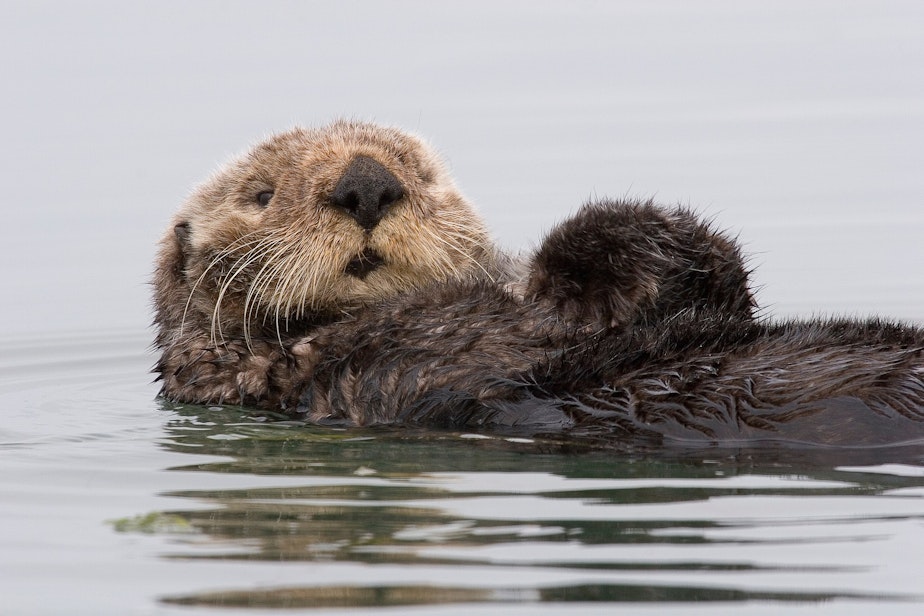Sea otter reintroduction to more of the Pacific Coast gets a nudge from Congress

Bringing back sea otters to the Oregon Coast just got a high-level endorsement. The federal budget for this new year, which President Trump signed after some unrelated last minute drama, includes a directive to study sea otter reintroduction.
The proviso making sea otter fans happy was tucked away deep in the new federal budget. Oregon Sen. Jeff Merkley added the paragraph to the massive 2021 federal budget bill. It directs the U.S. Fish and Wildlife Service to study the feasibility and cost of reestablishing the charismatic marine mammals where they were once hunted to near-extinction along the Pacific Coast.
Bob Bailey leads the Elakha Alliance, a group that wants to bring wild sea otters back to the Oregon Coast. His organization instigated the congressional action.
"I’m very pleased. This is very timely," Bailey said in an interview. "It will definitely help U.S. Fish and Wildlife Service develop a strategic approach for how best to conserve and protect sea otters on the Pacific Coast."
Other places besides the Oregon coast where advocates have suggested reestablishing sea otters include San Francisco Bay and southern California.
Sponsored
The Elakha Alliance has already launched its own reintroduction feasibility study focused on Oregon waters, which Bailey said could complement the broader federal report.
Sea otters were hunted to local extinction off the Pacific Northwest coast as part of the fur trade in the 18th and 19th centuries. Remnant populations survived off central California and western Alaska.
Sea otters were successfully reintroduced to Washington, British Columbia and southeast Alaska fifty years ago. It didn’t go so well along the southern Oregon Coast, where the otters released during the same time period mysteriously vanished after a few years. The animals have not naturally repopulated to Oregon in the time since.
The current Washington state population of around 2,000 animals stems from 59 sea otters that were relocated to the Olympic Peninsula coast from Alaska's Aleutian Islands in 1969 and 1970. They are now spread out between Point Grenville on the Quinault Reservation and Pillar Point in the Strait of Juan de Fuca. Occasionally, one or two Washington sea otters are spotted exploring Oregon waters, but those wandering animals have not stayed.
The Elakha Alliance is collaborating with coastal tribes and researchers from the University of Oregon, Oregon State University, the Seattle Aquarium and others to reexamine why the previous restoration attempt failed in Oregon and to figure out what could make it go better next time. "Elakha" is the Clatsop-Chinookan word for sea otter.
Sponsored
Super-cute sea otters could be good for tourism and their return would likely bring ecological benefits. But the fishing industry is wary. One of the things sea otters eat is Dungeness crab, which happens to be Oregon's single most valuable commercial fishery.
Sea otters are such voracious eaters, West Coast crab and sea urchin fishermen have gone on record with concerns and cautions. According to the Seattle Aquarium, sea otters consume around 25 percent of their body weight in food every day to stay warm and survive in the cold Pacific Ocean.
Last week, the Elakha Alliance announced it secured funding for an economic impact analysis to evaluate the costs and benefits of sea otter reintroduction on coastal communities. The announcement specifically noted the potential impact on Dungeness crab and sea urchin fisheries.
"Our office is certainly supportive of the reintroduction effort," said Sara Hottman, state communications director for Sen. Merkley, in an interview Tuesday.
Hottman said her boss is not only fond of sea otters themselves, but also holds a strong interest in seeing underwater kelp forests rebound. The two are directly related in that sea otters prey on sea urchins, which in turn can help foster kelp beds because urchins feast on kelp. Kelp forests are desirable as productive nurseries for a wide range of sea life.
Sponsored
Merkley, a Democrat, serves on the coveted Senate Appropriations Committee, which put him in a good position to advance his priorities during budget horse-trading -- even though Democrats were in the minority in the Senate.
The congressional directive to the U.S. Fish and Wildlife service did not include any extra money to conduct the federal sea otter restoration feasibility study and to produce a report by next December. However, the agency has subject matter experts on staff. The Elakha Alliance said its own feasibility study, now well underway, could provide "significant technical support" for the federal effort.
A Fish and Wildlife Service spokesperson was careful not to prejudge the reintroduction prospects in an email reply to a series of questions on Tuesday.
"A feasibility study will gather needed scientific information that will help make the best possible decision for sea otter recovery," said Portland-based agency spokesperson Jodie Delavan. "It is purely exploratory and does not imply a decision on whether to reintroduce sea otters." [Copyright 2021 Northwest News Network]

